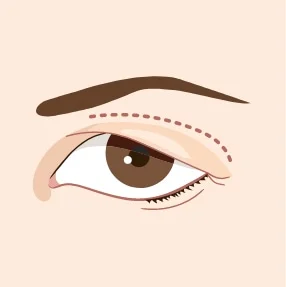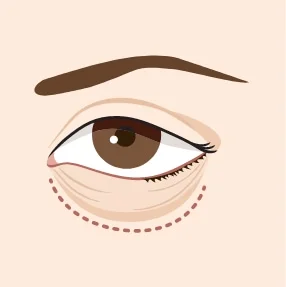The natural aging process can cause the tissues and muscles around the eyes to loosen and weaken. The brow and cheeks lose volume and descend with time contributing to the heaviness of the upper eyelids and cheeks. Descent of the cheek fat pads also leads to exposure of the underlying orbital bone structure, creating a shadow under the eye and resulting in a tired and aged appearance. Our Zionsville and Indianapolis-area facial plastic surgeon, Dr. Emily Hrisomalos, offers blepharoplasty to patients seeking to rejuvenate the eyes for a more youthful appearance. Also referred to as an eyelid lift, blepharoplasty can be an ideal solution to address puffiness, drooping/excess skin, and dark shadows around the eyes.
If you are interested in learning more about eyelid surgery and how it can benefit you, we invite you to explore the informative sections provided below.
What Is Eyelid Surgery?
Eyelid surgery is designed to rejuvenate the appearance of the eyelids by removing or repositioning excess skin, fat, and muscle in the upper and/or lower eyelid region. The procedure can help to resolve common concerns surrounding saggy, puffy, and wrinkled eyelid skin, as well as severely overhanging skin that may impair vision. The specific surgical techniques used during eyelid surgery are designed to work with the patient’s unique anatomy and aesthetic goals to create a natural-looking, more youthful aesthetic.
What Are the Benefits of Blepharoplasty?
Eyelid surgery offers many benefits to patients seeking a more refreshed, rested appearance in the upper and/or lower eye area, including:
- Smoother, firmer skin
- Reduced undereye bags, dark circles, sagging, and puffiness
- Enhanced contours in the eye area and greater overall facial balance
- A more alert, youthful appearance
- Unobstructed vision after removal of excess drooping skin
- Long-lasting results with minimal scarring
While eyelid surgery can achieve significant aesthetic improvement on its own, patients seeking more comprehensive facial rejuvenation may wish to combine blepharoplasty with other treatments, such as a facelift, brow lift, and/or dermal fillers. These procedures are designed to remove or reduce wrinkles and creases while addressing sagging facial skin for more holistic rejuvenation.
What Are the Different Types of Blepharoplasty?

Upper Blepharoplasty
Patients who feel that their upper eyelids are “heavy,” or have noticed excess skin in the upper eyelids may benefit from an upper blepharoplasty procedure. Some patients feel their eyes look smaller or experience difficulty with applying makeup to the upper eyelids due to this skin redundancy. Some even have visual difficulty in the upper fields due to eyelid heaviness. Upper eyelid surgery can be performed for cosmetic reasons as well as for functional concerns and can optimize quality of life significantly.

Lower Blepharoplasty
Individuals who want to address “bags” or dark circles under the eye may find that lower blepharoplasty is an optimal solution. Dr. Hrisomalos often uses fat transposition along with other techniques to improve lower eyelid contour and optimize longevity.
Depending on your needs and cosmetic goals, Dr. Hrisomalos may recommend incorporating one or both types of blepharoplasty into your personalized treatment plan. Recovery is similar between upper and lower recovery and is mostly “social.” Physical recovery is typically anywhere from just a couple of days to about two weeks. “Social” recovery varies based on the comfort level of patients being seen during the different stages of healing. Final results will take several months to realize; however, fortunately, the majority of healing takes place within the first few weeks. Dr. Hrisomalos will go over all procedure details and recovery timeline in more detail during your consultation so you know exactly what to expect.
What is Recovery Like After Eyelid Surgery?
Following eyelid surgery, common side effects will likely include swelling, bruising, soreness, and tightness, which usually subside within a few days. During this time, it is recommended to keep your head elevated while resting/sleeping and use cold compresses to alleviate swelling. Additionally, oral pain medication may be taken as prescribed to help ease any discomfort. Generally, sutures will be removed after five to seven days and patients can return to work and normal activities, pending physician approval. In some cases, patients experience blurry vision, sensitivity to light, or dry eyes for a period of time during recovery but these symptoms should resolve during the healing process.



